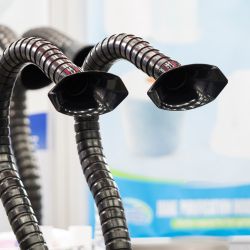Solder fume extraction systems, also known as solder smoke or solder fume extractors, are critical tools in electronics manufacturing and soldering processes.
These systems are designed to remove and filter harmful fumes and particles generated during soldering operations, ensuring a safe and healthy working environment for operators. In this article, we will explore how solder fume extraction systems work and their importance in various solder fume extraction.
Working Principle: Solder fume extraction systems operate on the principle of capturing, filtering, and exhausting airborne contaminants produced during soldering. Here’s a step-by-step breakdown of their functioning:
- Capture: The first step involves capturing the solder fumes at the source. This is typically done using a fume capture hood or arm positioned near the soldering work area. This hood or arm creates a localized airflow that draws in the contaminated air, ensuring that the fumes are captured right at their origin.
- Transportation: Once captured, the contaminated air is then transported through a network of ducts or hoses. These ducts are designed to carry the fumes away from the operator’s breathing zone and into the extraction system.
- Filtration: Within the extraction system, the contaminated air passes through a series of filters designed to remove harmful particulates and gases. There are typically two types of filters used in solder fume extraction systems:a. Particulate Filters: These filters capture solid particles suspended in the air, such as solder flux, soldering debris, and other contaminants. The most common type of particulate filter is a HEPA (High-Efficiency Particulate Air) filter, which is highly effective at removing particles as small as 0.3 microns.b. Gas Filters: To remove harmful gases and volatile organic compounds (VOCs) generated during soldering, activated carbon filters are often used. Activated carbon has a high adsorption capacity and can trap a wide range of gases and odors.
- Clean Air Return: After passing through the filters, the cleaned air is returned to the workspace or, in some cases, exhausted outside the facility. The decision to recirculate the air or exhaust it depends on the specific requirements of the application and local regulations.
- Monitoring and Control: Many modern solder fume extraction systems are equipped with sensors and control panels that monitor air quality and filter performance. If the filters become saturated or airflow drops below a certain threshold, the system will signal the need for maintenance or filter replacement.
Importance of Solder Fume Extraction Systems:
Solder fume extraction systems play a crucial role in various industries for several reasons:
- Worker Safety: Soldering processes release hazardous fumes, including lead, rosin, and other chemicals. Exposure to these fumes can lead to respiratory problems, eye irritation, and other health issues. Extractors protect operators by removing these harmful contaminants from the air.
- Compliance: Many countries and regions have strict regulations regarding air quality and occupational health. Using a solder fume extraction system helps companies comply with these regulations and avoid potential fines or legal issues.
- Product Quality: Solder fumes can settle on circuit boards and components, leading to defects and reduced product quality. Extractors help maintain a clean working environment, ensuring high-quality solder joints.
- Environmental Responsibility: Proper filtration and exhaust systems prevent the release of harmful pollutants into the atmosphere, contributing to a cleaner and more sustainable environment.
- Longevity of Equipment: Soldering equipment, such as soldering irons and tips, can be negatively affected by the buildup of solder fumes. Extractors help extend the lifespan of these tools by reducing their exposure to corrosive fumes.
In conclusion, solder fume extraction systems are essential for creating a safe and healthy workspace in soldering and electronics manufacturing environments. By capturing, filtering, and exhausting harmful fumes and particles, these systems protect the well-being of operators, ensure compliance with regulations, maintain product quality, and contribute to a cleaner environment. Investing in a high-quality solder fume extraction system is not only a responsible choice but also a smart one for businesses in these industries.






